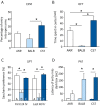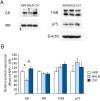Enhanced social reward response and anxiety-like behavior with downregulation of nucleus accumbens glucocorticoid receptor in BALB/c mice
- PMID: 36403974
- PMCID: PMC9887208
- DOI: 10.1292/jvms.22-0103
Enhanced social reward response and anxiety-like behavior with downregulation of nucleus accumbens glucocorticoid receptor in BALB/c mice
Abstract
Social anhedonia is a psychological state with difficulty in experiencing pleasure from social interactions and is observed in various diseases, such as depressive disorders. Although the relationships between social reward responses and anxiety- and depression-like behaviors have remained unclear, a social reward conditioned place preference (SCPP) test can be used to analyze the rewarding nature of social interactions. To elucidate these relationships, we used 5-week-old male mice of AKR, BALB/c, and C57BL/6J strains and conducted behavioral tests in the following order: elevated plus-maze test (EPM), open field test (OFT), SCPP, saccharin preference test (SPT), and passive avoidance test. The nucleus accumbens of these mice were collected 24 hr after these behavioral tests and were used for western blotting to determine the levels of receptors for brain-derived neurotrophic factors and glucocorticoids. BALB/c mice displayed the highest levels of anxiety-like behavior in EPM and OFT as well as physical anhedonia-like behaviors in SPT. They also showed increased responses to social rewards and huddling behaviors in SCPP, with downregulated glucocorticoid receptor (GR). Regression analysis results revealed positive influences of anxiety- and physical anhedonia-like behaviors and expressions of GR on social reward responses. Collectively, temperament associated with anxiety and physical anhedonia may affect social reward responses, which possibly is influenced by the expression of GR that can modify these psychological traits.
Keywords: anhedonia; anxiety; depression; glucocorticoid receptor; nucleus accumbens; social reward.
Conflict of interest statement
The authors declare no conflicts of interest.
Figures




Similar articles
-
Chronic restraint stress causes anxiety- and depression-like behaviors, downregulates glucocorticoid receptor expression, and attenuates glutamate release induced by brain-derived neurotrophic factor in the prefrontal cortex.Prog Neuropsychopharmacol Biol Psychiatry. 2012 Oct 1;39(1):112-9. doi: 10.1016/j.pnpbp.2012.05.018. Epub 2012 Jun 1. Prog Neuropsychopharmacol Biol Psychiatry. 2012. PMID: 22664354
-
SIRT1 Mediates Depression-Like Behaviors in the Nucleus Accumbens.J Neurosci. 2016 Aug 10;36(32):8441-52. doi: 10.1523/JNEUROSCI.0212-16.2016. J Neurosci. 2016. PMID: 27511015 Free PMC article.
-
Glucocorticoid receptor deletion from the dorsal raphé nucleus of mice reduces dysphoria-like behavior and impairs hypothalamic-pituitary-adrenocortical axis feedback inhibition.Eur J Neurosci. 2014 May;39(10):1671-81. doi: 10.1111/ejn.12538. Epub 2014 Mar 29. Eur J Neurosci. 2014. PMID: 24684372 Free PMC article.
-
Blockade of TrkB receptors in the nucleus accumbens prior to heterotypic stress alters corticotropin-releasing hormone (CRH), vesicular glutamate transporter 2 (vGluT2) and glucocorticoid receptor (GR) within the mesolimbic pathway.Horm Behav. 2017 Apr;90:98-112. doi: 10.1016/j.yhbeh.2017.02.012. Epub 2017 Mar 15. Horm Behav. 2017. PMID: 28257759
-
A review of the effects of different types of social behaviors on the recruitment of neuropeptides and neurotransmitters in the nucleus accumbens.Front Neuroendocrinol. 2025 Apr;77:101175. doi: 10.1016/j.yfrne.2025.101175. Epub 2025 Jan 31. Front Neuroendocrinol. 2025. PMID: 39892577 Review.
Cited by
-
An Interaction between Brain-Derived Neurotrophic Factor and Stress-Related Glucocorticoids in the Pathophysiology of Alzheimer's Disease.Int J Mol Sci. 2024 Jan 27;25(3):1596. doi: 10.3390/ijms25031596. Int J Mol Sci. 2024. PMID: 38338875 Free PMC article. Review.
References
-
- Barik J, Parnaudeau S, Saint Amaux AL, Guiard BP, Golib Dzib JF, Bocquet O, Bailly A, Benecke A, Tronche F. 2010. Glucocorticoid receptors in dopaminoceptive neurons, key for cocaine, are dispensable for molecular and behavioral morphine responses. Biol Psychiatry 68: 231–239. doi: 10.1016/j.biopsych.2010.03.037 - DOI - PubMed

